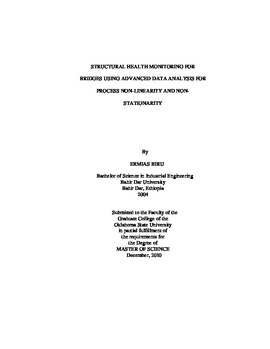| dc.contributor.advisor | Kong, Zhenyu (James) | |
| dc.contributor.author | Biru, Ermias | |
| dc.date.accessioned | 2014-04-17T19:44:33Z | |
| dc.date.available | 2014-04-17T19:44:33Z | |
| dc.date.issued | 2010-12-01 | |
| dc.identifier.uri | https://hdl.handle.net/11244/9845 | |
| dc.description.abstract | The proposed research is focused on data analysis using time series modeling approaches, frequency domain analysis and statistical hypothesis testing for the purpose of Structural Health Monitoring. In this study a detailed time series modeling for data obtained from a functional bridge is investigated. The relationship between measured deformation values from different sensors installed on a bridge column is studied. The study also showed the relationship between temperature and deformation measured by sensors installed on the column of the bridge. Spectral analysis approaches which include Fourier transform, wavelet analysis and Hilbert transform are applied for a bench mark problem using simulation data. A statistical hypothesis testing is also applied in conjunction with the Hilbert transform to differentiate between a change in mean and variance of instantaneous frequency of the simulated data which was obtained from normal and damaged conditions of a structure. The research showed that the applied time series and spectral analysis methodologies are effective for SHM application. From the analysis of bridge sensor data it is shown that the deformation developed in the columns of a bridge was increasing through time and also there exists a high correlation between temperature and deformation recorded by the sensors. A case study was developed to show the effectiveness and validity of the frequency domain approaches. A change in frequency is observed from the Fourier analysis when data gathered from a damaged and undamaged state is considered. The wavelet approach was successful in capturing change of scale (frequency) with time. From the comparison of the spectral analysis presented the Hilbert transform and empirical mode decomposition (EMD) were found to be the best approach compared with Fourier and wavelet analysis since it showed change in frequency at any instant of time. Coupled with statistical hypothesis testing, the Hilbert transform detected the change in the mean and variance of instantaneous frequency through time which signifies the presence of damage. | |
| dc.format | application/pdf | |
| dc.language | en_US | |
| dc.publisher | Oklahoma State University | |
| dc.rights | Copyright is held by the author who has granted the Oklahoma State University Library the non-exclusive right to share this material in its institutional repository. Contact Digital Library Services at lib-dls@okstate.edu or 405-744-9161 for the permission policy on the use, reproduction or distribution of this material. | |
| dc.title | Structural Health Monitoring for Bridges Using Advanced Data Analysis for Process Non-linearity and Non- Stationarity | |
| dc.type | text | |
| dc.contributor.committeeMember | Liu, Tieming | |
| dc.contributor.committeeMember | Ley, Tyler | |
| osu.filename | BIRU_okstate_0664M_11257.pdf | |
| osu.college | Engineering, Architecture, and Technology | |
| osu.accesstype | Open Access | |
| dc.description.department | Industrial Engineering & Management | |
| dc.type.genre | Thesis | |
